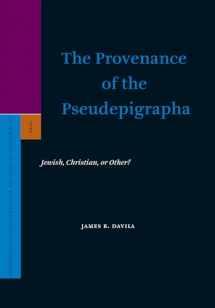
The Provenance of the Pseudepigrapha: Jewish, Christian, or Other? (Supplements to the Journal for the Study of Judaism)
ISBN-13:
9789004137523
ISBN-10:
9004137521
Edition:
First Edition
Author:
James R. Davila
Publication date:
2005
Publisher:
Brill
Format:
Hardcover
282 pages
Category:
Christian Books & Bibles
FREE US shipping
on ALL non-marketplace orders
Marketplace
from $149.61
USD
Marketplace offers
Seller
Condition
Note
Seller
Condition
Used - Like New
Sealed in original shrinkwrap.
Book details
ISBN-13:
9789004137523
ISBN-10:
9004137521
Edition:
First Edition
Author:
James R. Davila
Publication date:
2005
Publisher:
Brill
Format:
Hardcover
282 pages
Category:
Christian Books & Bibles
Summary
The Provenance of the Pseudepigrapha: Jewish, Christian, or Other? (Supplements to the Journal for the Study of Judaism) (ISBN-13: 9789004137523 and ISBN-10: 9004137521), written by authors
James R. Davila, was published by Brill in 2005.
With an overall rating of 3.7 stars, it's a notable title among other
Christian Books & Bibles
books. You can easily purchase or rent The Provenance of the Pseudepigrapha: Jewish, Christian, or Other? (Supplements to the Journal for the Study of Judaism) (Hardcover) from BooksRun,
along with many other new and used
Christian Books & Bibles
books
and textbooks.
And, if you're looking to sell your copy, our current buyback offer is $0.3.
Description
The Old Testament pseudepigrapha are ancient quasi-biblical texts inspired by the Hebrew Bible. Although frequently mined as Jewish background by New Testament specialists, they were transmitted almost entirely in Christian circles, often only in translation. Christian authors wrote some pseudepigrapha and did not necessarily always mention explicitly Christian topics. This book challenges the assumption that pseudepigrapha are Jewish compositions until proven otherwise. It proposes a methodology for understanding them first in the social context of their earliest manuscripts, inferring still earlier origins only as required by positive evidence while considering the full range of possible authors (Jews, Christians, "God-fearers," Samaritans, etc.). It analyzes a substantial corpus of pseudepigrapha, distinguishing those that are probably Jewish from those of more doubtful origins.


We would LOVE it if you could help us and other readers by reviewing the book
Book review

Congratulations! We have received your book review.
{user}
{createdAt}
by {truncated_author}


